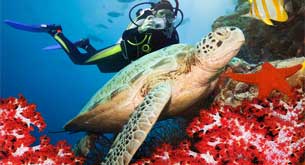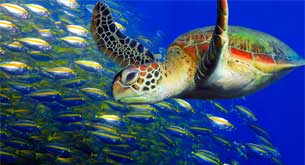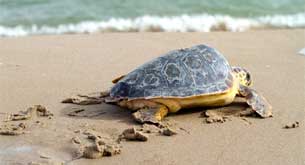Facts about Sea Turtles
Posted by Admin / in Science Facts
Sea turtles are reptiles that are born on land, but live most of their life in the water. Most sea turtles have hard shells on their backs, but the leatherback turtle has a rubber, leather-like skin instead. Sea turtles scaley skin, streamlined body, and feet that look like little flippers make them perfect for survival in the water. Like other reptiles, sea turtles are cold-blooded. Unlike most animals that live in the water, sea turtles must breathe air so they must hold their breath while they are underwater. Sea turtles are great at holding their breath. While they sleep, many sea turtles can hold their breath for up to 2 hours at a time!

Huge Sea Turtles are a wonder to watch in the ocean
How Many Types of Sea Turtles Are There?
There are 7 different types of sea turtles swimming the oceans of the world. The smallest is Kemp's Ridley turtle that grows to a maximum weight of about 100 pounds and a maximum length of about 2.5 feet. The largest type of sea turtle is the leatherback turtle. The largest leatherback turtles are much bigger than any other turtle.
Hawksbill Sea Turtles: Hawksbill turtles are medium size and typically live near the coral reef of tropical seas. Their main food they eat is sponges. They are named Hawksbill because of their mouth that looks like a hawk's beak. Hawksbill turtles are the only sea turtle with claws on its flippers.
Leatherback Sea Turtles: Leatherback turtles can grow as large as 8 feet long and weigh over 2000 pounds. Leatherback turtles have built imunity against a jellyfish sting. The main part of their diet is the jellyfish, making it one of the only predators of a jellyfish.
Olive Ridley Sea Turtles Olive Ridley sea turtles are known for their olive-color, heart-shaped shells. They also have the longest flipper of any sea turtle which makes them easily recognizable. They are small sea turtles, similar in size to the Kemp's Ridley turtles.
Kemp's Ridley Sea Turtles: Kemp's Ridley turtles are the smallest species of sea turtle. Adults can reach a weight of up to 80-120 pounds. They live most near Mexico in the Gulf of Mexico, but are also found in the Atlantic Ocean from Florida and as far north as new England during late summer. Possibly because of their smaller size, Kemp's Ridley turtles spend a majority of their life in the shallower waters near the coast of land. Their main diet consists of crabs with some smaller ocean animals and plants.
Flatback Sea Turtles Flatback sea turtles are only found off the coast of Australia. Most turtles have high domed shells, but flatback turtles are known for their smooth flat shells. Flatback sea turtles spend most of their live in bays and shallow waters off the coast.
Loggerhead Sea Turtles The Loggerhead sea turtles are known for their large heads and unique patterned skin. They can grow as large as 500 pounds. They live mostly near the oceans near southeast U.S.. When Loggerhead turtles are younger, they live in the open oceans, but return to shallower waters, near the coast, when they reach maturity.

Green Sea Turtles live in Tropical or Subtropical Waters
Green Sea Turtles: Green sea turtles are the largest of the hard-shell turtles and can grow up to 500 pounds. They mainly eat sea grass and algae. Green sea turtles live in warm waters in subtropical and tropical areas. The green sea turtle is named after its sometimes green skin color and green algae that grows on its shell.
Protecting Sea Turtles

Sea Turtles are vulnerable when they nest
Sea turtles were once plentiful in the oceans, but because of turtle hunting, fishing, and destruction of beaches where they nest, all 7 types of sea turtles are endangered or threatened. There are some actions people can take to try to help limit damaging turtles nesting areas and limit other things that can harm sea turtles.
Interesting Sea Turtle Facts
- Scientists have recently studied how sea turtles swim. Sea turtles only use their flippers to swim unlike fish who have more moving parts. Ironically, scientists are now designing underwater robots to swim like sea turtles because their motion is more efficient.
- Sea turtles have an extremely low heart rate which allows them to stay underwater for a long period of time. During an extend dive, sea turtles hearts may only beat once every nine minutes.
- Sea turtles do not have teeth. Instead, sea turtles have sharp jaws.
TYPES OF SEA TURTLES
-
Hawksbill Sea Turtles: - Medium size sea turtle - mostly eats sponges
-
Leatherback Sea Turtles: - Largest sea turtle - mostly eats jellyfish
-
Olive Ridley Sea Turtles: - Small sea turtle - diet consists of shrimp, jellyfish, crabs, rock lobster and algae
-
Kemp's Ridley Sea Turtles: - Smallest sea turtle - mostly eats crabs
-
Flatback Sea Turtles: - Medium size sea turtles - diet consists of prawns, jellyfish, mollusks, seaweed and sea cucumbers
-
Loggerhead Sea Turtles: Medium to large sea turtles - eats shell animals from the ocean floor
-
Green Sea Turtles: Largest of the hard-shell turtles - mainly eats sea grass and algae
FACTS ABOUT PROTECTING SEA TURTLES
-
All sea turtles nest on the beach. Nesting spots are typically away from the water near natural sand dunes. Take care in these areas to not disturb turtle eggs.
-
Sea turtles, like other reptiles, must breathe air from the surface. Fishing nets and old fishing line or rope in the water can trap sea turtles. When trapped sea turtles cannot reach the surface so they drown.
-
Many sea turtles eat jellyfish. Plastic bags and balloons floating in the water resemble jellyfish. When sea turtles eat balloons or plastic bags they are at risk. Pick up trash at the beach and never release helium balloons near the ocean.
-
Most sea turtles hatch at night. When sea turtles hatch they look for the ocean which is naturally lighter than land. When there are street lights or house lights on during this time, the turtles may confuse these artificial light sources with the ocean. Turn off artificial lights at night if you live near the ocean or are staying near the beach.
-
Dogs have a great sense of smell and may try to dig up turtle eggs. When walking dogs on the beach keep them away from turtle nesting areas and do not let them roam free to dig and damage turtle nests.
